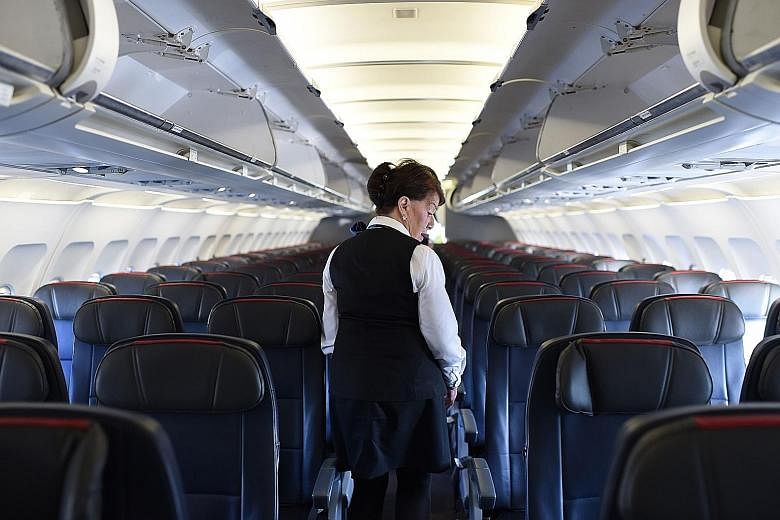HOUSTON • You are on a plane and in the mood for in-flight entertainment. But where is that seat-back screen?
Here is the big picture.
Airlines have been shrinking their seats for a long time, aiming to reduce the planes' weight and squeeze in more passengers.
However, lately, some carriers have gone one step further in redesigning the seats. They have taken away the seat-back screens.
The screens and the pre-selected media on them go a long way towards keeping passengers happy.
But those entertainment systems are expensive to install. They can cost US$10,000 (S$13,370) a seat, said Mr Dan McKone, managing director and head of the travel and transportation practice at consulting firm L.E.K.
They also add bulk and weight to seats and quickly become technologically obsolete, especially because many passengers are now flying with at least one mobile device, said Mr Henry Harteveldt, travel industry analyst and co-founder of Atmosphere Research Group.
"Some airlines are looking at this from the standpoint of cost savings by removing the hardware.
"They reduce the weight of the aircraft and they reduce the expense associated with maintaining that equipment," he adds.
American and United Airlines are phasing out screens on new short-haul aircraft in favour of content offerings that passengers can stream on their personal devices.
The decision on whether to update the screens, Mr McKone said, is mainly economic. He predicts that more domestic flights in the future will offer content streaming on a bring-your-own-device model.
Some travellers are happy to say "good riddance" to the seat-back screens. Ms Lindsay Renfro, an associate professor at the Mayo Clinic, travels once a month and views seat-back entertainment as redundant.
"There are screens everywhere else in life," she noted. "I know that when I am flying and I look around me, people are by and large using personal devices, even when a seat-back screen is available."
That is one of the reasons Hawaiian Airlines is going without these screens in its new A321 planes, its chief commercial officer Peter Ingram said.
"With the 321, we recognised a couple of things that are changing in the environment around us that informed our decision," he adds. "The majority of people are showing up with a device of their own and they're ignoring the devices we offer in-seat."
He notes that the rapid pace of technological change means an installed entertainment system will soon be obsolete.
But industry experts say airlines risk alienating those travellers who do not want to rely on their own device to be entertained while they fly.
Mr Patrick Ligonde travels with his smartphone for his job in airline ground operations. But when he has to fly from his home base in Philadelphia, he makes sure the seats he buys have seat-back screens, even going so far as to research the aircraft configuration before making a seat selection.
One advantage, he added, is that he does not arrive at his destination with a dead battery if he were to use his own personal device.
Mr Harteveldt said his company's research indicates that many road warriors have the same preference.
"Business travellers have said there's no room to have a smartphone on their tray if they're working on a laptop, or if they're using a tablet or smartphone for work, it's difficult to use that for watching entertainment. Having the separate screen is a plus for them," he adds.
Some airlines are betting that they can peel away market share from competitors by catering to travellers such as Mr Ligonde, making in-flight entertainment a brand differentiator.
Last year, Delta rolled out free in-flight mobile messaging and is installing new screens and making more content available.
Alaska Airlines also started offering free in-flight messaging last year, along with faster Wi-Fi.
JetBlue Airways, which has made in-flight entertainment a crucial part of its brand image since its debut, is investing in entertainment systems for its A320 and A321 planes, said Ms Mariya Stoyanova, director of product development.
"When we took off flying in 2000, we had live TV in every seat. That was something unheard-of at the time," she said.
"That's part of our brand commitment."
NYTIMES

